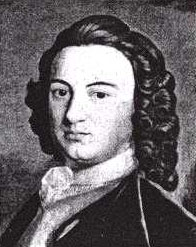- James Bowdoin
Infobox Governor
name = James Bowdoin
imagesize = 196px
order = 2nd
office = Governor of Massachusetts
term_start = 1785
term_end = 1787
lieutenant =Thomas Cushing
predecessor =Thomas Cushing (acting)
successor =John Hancock
birth_date = birth date|1726|8|7|mf=y
birth_place =Boston, Massachusetts
death_date = death date and age|1790|11|6|1726|8|7|mf=y
death_place =Boston Massachusetts
party = None
spouse =
profession =
religion =James Bowdoin (August 7, 1726ndash November 6, 1790) was an American political and intellectual leader from Boston,
Massachusetts during theAmerican Revolution . He served in both branches of theMassachusetts General Court in the colonial era and was president of the state's constitutional convention. After independence he was governor of Massachusetts.Bowdoin was born in Boston to Hannah Portage Bowdoin and James Bowdoin, a wealthy Boston
merchant . His grandfather Pierre Boudouin was aHuguenot refugee fromFrance .Pierre took his family first toIreland , then toPortland, Maine , finally settling in Boston in 1690.Young James attended
Boston Latin School , then graduated fromHarvard in 1745. When his father died in 1747, he inherited a considerable fortune. He took an early interest in Natural History, and had several papers read to theRoyal Society inLondon by his friend and correspondent,Benjamin Franklin .Bowdoin was elected to the
Massachusetts House of Representatives in 1753 and served there until named to the Council in 1756. By the end of Sir Francis Bernard's term as governor he spoke and wrote against the royal governors and their actions. He was proposed as a continuing Council member in 1769, but the new governor Thomas Hutchinson rejected his membership. Boston promptly elected him to the House. When Hutchinson was formally commissioned as governor in 1760, he restored Bowdoin to the Council, reasoning that he was less dangerous there than as an outspoken critic in the House.Bowdoin as named as a delegate to the
First Continental Congress in 1774 but did not attend, citing health reasons. In 1775 he was elected President of the Council and held that office until 1777. With the turmoil of theAmerican Revolutionary War , he sometimes acted as council president in an executive, rather than legislative role. When Massachusetts wrote its own constitution in 1779, he was president of the Convention which created it, and chairman of the committee that drafted it. His son,James Bowdoin III , also sat in this convention. Under the new state government, governorJohn Hancock appointed him to a commission to revise and consolidate the laws from colonial days.In 1785, Bowdoin was elected Governor of Massachusetts, but his terms were not peaceful. He called up the militia and took vigorous action to put down
Shays' Rebellion , and as a result lost the election of 1787 as Hancock was swept back into office. In 1788 he served as a member of the Massachusetts convention that ratified theUnited States Constitution .Throughout this period, he maintained his interest in learning a natural history. In 1780 he was primarily responsible for the creation of the
American Academy of Arts and Sciences . He served as its first president until his death and left the society his library. Bowdoin continued to publish not only scientific papers, but verse in both English and Latin. He was awarded anhonorary doctorate by theUniversity of Edinburgh , made a fellow of Harvard, and was a member of the Royal Society of both London andEdinburgh .He died of
tuberculosis on November 6, 1790, in Boston.Bowdoin College inMaine was named in his honor, as his son,James Bowdoin III had provided the principal endowment for its foundation.ee also
Dudley-Winthrop Family External links
* [http://www.mass.gov/statehouse/massgovs/jbowdoin.htm Official Commonwealth of Massachusetts Governor Biography]
Wikimedia Foundation. 2010.
